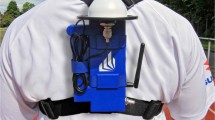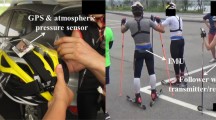Abstract
Objective information on athletic maneuvers for performance evaluation has become highly desired in sports such as skiing, snowboarding, and mountain biking. Body-mounted devices, incorporating low-cost microelectromechanical, inertial navigation units, and global positioning system (GPS) receivers, to calculate sport-specific key performance variables (KPVs) and provide real-time feedback, are now commercially available. However, algorithms implemented for such purposes still lack accuracy and power efficiency. A new GPS/INS (inertial navigation system) integration algorithm is proposed to determine the trajectory of an athlete executing jumps while skiing, snowboarding, mountain biking etc. KPVs, such as jump horizontal distance, vertical height, and drop, are calculated from the trajectory. A new sensor error compensation scheme is developed using sensor fusion and linear Kalman filters (LKF). The LKF parameters are varied to address the fluctuating dynamics of the athlete during a jump. The extended Kalman filter used for GPS/INS integration has an observation vector augmented with sensor error measurements derived from sensor fusion. The performance of the proposed algorithm is evaluated through experimental field tests. For the determination of jump horizontal distance, height, and drop, the proposed algorithm has errors of 14.3 cm (5.5 %), 1.6 cm (38 %), and 6.7 cm (9.4 %), respectively. Errors in KPVs for a set of jumps were first determined with respect to the true KPVs, and then the errors for all the jumps were averaged to calculate the absolute and percentage errors. The accuracy achieved is deemed to fulfill the expectations of both recreational and professional athletes.











Similar content being viewed by others
References
Aggarwal P, Syed Z, Noureldin A, El-Sheimy N (2010) MEMS-based integrated navigation. Artech House, Norwood
Bortz J (1971) A new mathematical formulation for strapdown inertial navigation. Aerosp Electron Syst IEEE Transact AES 7(1):61–66. doi:10.1109/TAES.1971.310252
Boyd LJ, Ball K, Aughey RJ (2011) The reliability of MinimaxX accelerometers for measuring physical activity in Australian football. Int J Sports Physiol Perform 6(3):311–321
Diebel J (2006) Representing attitude: Euler angles, unit quaternions, and rotation vectors. Technical report, Stanford University, Stanford, CA 94301-9010
El-Sheimy N, Nassar S, Shin EH, Niu X (2006) Analysis of various Kalman filter algorithms using different inertial navigation systems integrated with the global positioning system. Can Aeronaut Space J 52(2):59–67
Godha S, Cannon M (2005) Integration of DGPS with a low cost MEMS-based inertial measurement unit (IMU) for land vehicle navigation application. ION GPS-05, September 13–16, 2005, Long Beach, CA
Godha S, Cannon M (2007) GPS/MEMS INS integrated system for navigation in urban areas. GPS Solut 11(3):193–203
Harding JW, Small JW, James DA (2007a) Feature extraction of performance variables in elite half-pipe snowboarding using body mounted inertial sensors, vol 6799. In: BioMEMS and nanotechnology III, proceedings of SPIE, pp 679917-1–679917-12
Harding JW, Toohey K, Martin DT, Mackintosh CG, Lindh A, James DA (2007b) Automated inertial feedback for half-pipe snowboard competition and the community perception. In: The impact of technology on sport II, pp 845–850
Ignagni M (1994) On the orientation vector differential equation in strapdown inertial systems. Aerosp Electron Syst IEEE Transact AES 30(4):1076–1081. doi:10.1109/7.328757
Kay SM (1993) Fundamentals of statistical signal processing: estimation theory. Prentice Hall PTR, Upper Saddle River
Larsson P (2003) Global positioning system and sport-specific testing. Sports Med 3(15):1093–1101
Li Y, Dempster A, Li B, Wang J, Rizos C (2006a) A low-cost attitude heading reference system by combination of GPS and magnetometers and MEMS inertial sensors for mobile applications. J Glob Position Syst 5(1–2):90–97
Li Y, Wang J, Rizos C, Mumford P, Ding W (2006b) Low-cost tightly coupled GPS/INS integration based on a nonlinear Kalman filtering design. In: Proceedings of the ION NTM
Luinge H, Veltink P (2005) Measuring orientation of human body segments using miniature gyroscopes and accelerometers. Med Biol Eng Comput 43:273–282. doi:10.1007/BF02345966. URL: http://dx.doi.org/10.1007/BF02345966
Nassar S, El-Sheimy N (2005) A combined algorithm of improving INS error modeling and sensor measurements for accurate INS/GPS navigation. GPS Solut 10:29–39. doi:10.1007/s10291-005-0149-3
Nebot E, Durrant-Whyte H (1999) Initial calibration and alignment of low-cost inertial navigation units for land vehicle applications. J Robot Syst 2(16):82–92
Rogers RM (2000) Applied mathematics in integrated navigation systems. AIAA education series
Sadi F (2011) Jump parameter estimation with low cost MEMS sensors and GPS for action sports goggles. Master’s thesis, School of Engineering, The University of British Columbia
Savage PG (2002) Analytical modeling of sensor quantization in strapdown inertial navigation error equations. J Guid Control Dyn 25:833–842
Shin EH (2005) Estimation techniques for low-cost inertial navigation. PhD thesis, Department of Geomatics Engineering, University of Calgary, Canada
Titterton DH, Weston JL (2004) Strapdown inertial navigation technology, 2nd edn. The Institution of Electrical Engineers and The American Institute of Aeronautics and Astronautics, OH
Waegli A, Skaloud J (2009) Optimization of two GPS/MEMS-IMU integration strategies with application to sports. GPS Solut 13:315–326. doi:10.1007/s10291-009-0124-5. URL: http://dx.doi.org/10.1007/s10291-009-01245
Walchko KJ, Mason DPAC (2002) Inertial navigation. In: Proceedings of the 15th annual Florida conference on recent advances in robotics. Florida International University (FIU) in Miami on May 23–24, 2002
Waegli A, Skaloud J, Tome P (2007) Assessment of the integration strategy between GPS and body-worn MEMS sensors with application to sports. The Institute of Navigation ION GNSS 2007, September 25–28, Fort Worth, TX
Author information
Authors and Affiliations
Corresponding author
Rights and permissions
About this article
Cite this article
Sadi, F., Klukas, R. New jump trajectory determination method using low-cost MEMS sensor fusion and augmented observations for GPS/INS integration. GPS Solut 17, 139–152 (2013). https://doi.org/10.1007/s10291-012-0267-7
Received:
Accepted:
Published:
Issue Date:
DOI: https://doi.org/10.1007/s10291-012-0267-7




